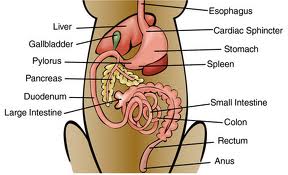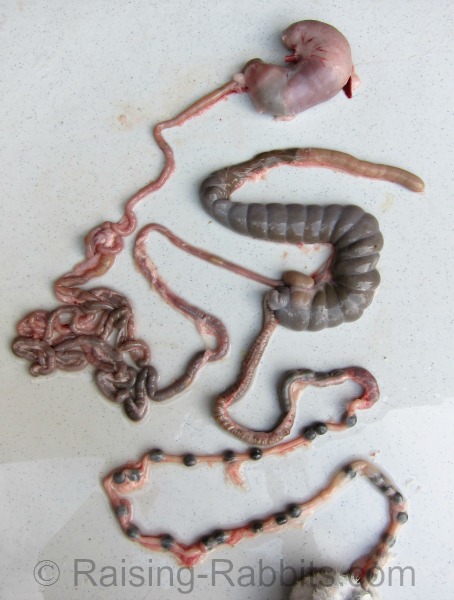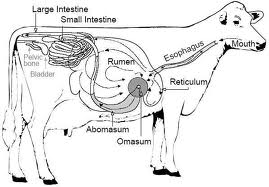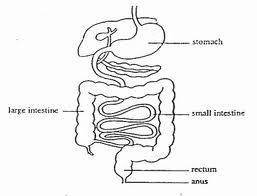Carnivore Digestive System
Compare and contrast the carnivore digestive system to the herbivore digestive system and to the human digestive system. Here is the unmistakable answer to whether humans are herbivore, carnivore, or omnivore.
A pure carnivore has a simple tube for an intestinal system. That tube has a bulge at the beginning of it that serves as a stomach. The tube then winds and twists inside the abdomen of the carnivore. It needs to - it is roughly 6 times longer than the animal is, when measured in a living animal.
Starting at the mouth, here is how a carnivore digestive system works:
Jaws and Teeth:
Carnivores have canine teeth, also called carnivore teeth. The adult canine teeth of a dog number 42. Canine teeth rip and tear the flesh of its prey, and the jaws chew up and down, rather than side to side. Many times the carnivore ‘wolfs’ his food nearly whole. Some carnivores can go several days before they need to hunt and feed again.

Stomach:
A dog’s stomach can hold about 2 quarts of contents (4 pints, or 8 cups). It secretes hydrochloric acid for digesting and breaking down the food into liquid ‘chyme.’
Small Intestine:
Once broken down into its constituent parts, the small intestine is where the nutrients get absorbed into the blood stream. Digestion and absorption of nutrients (fat and protein) is extremely efficient. Less than 4% of fat, and just trace amounts of protein make it beyond the small intestine into the large intestine.
Carnivores have NO enzymes for digesting cellulose, a complex carbohydrate and the main building block in plant cell walls. Obligate carnivores such as cats and dogs cannot digest cellulose.
Cecum:
The cecum in a carnivore digestive system is a tiny useless appendage.
In dogs, the cecum is equivalent to the human appendix. It is an S-shaped blind pouch that joins the intestines at the junction of the small and the large intestines. If it has any function, it is a very minor one. Dogs do not have an appendix.
Large Intestine:
The large intestine (colon) serves a single purpose - to reabsorb the water out of the waste material. Anything left over at the other end of the long tube passes out and turns into manure.
Intestinal Flora:
Thanks to the hydrochloric acid in the stomach, the entire
carnivore digestive system is close to sterile, until the large intestine. A very large
population of healthy bacteria resides in the colon. This natural gut flora
participates in immune system function by competing with and helping to
minimize the presence of dangerous bacteria. While the bacteria manufacture
b-vitamins, biotin, vitamin K and folic acid, it is unclear whether these
nutrients are bioavailable to the carnivore.
Herbivore Digestive Systems
Compared to Carnivore Digestive Systems
Two distinct types of herbivore digestive systems exist.
- The horse, rabbit, gorilla and others have a single stomach and a gigantic cecum (huge blind pouch) which contains billions of bacteria and participates in digestion.
- The cow, goat, camel and sheep, among
others, have multiple, very complex stomachs, the first three of which contain billions of bacteria that help digest plant cellulose.

The herbivore's intestines are up to 27 times
longer than the length of its body, when measured in a living
animal. This is because the process of digesting cellulose is long and
difficult, and requires the help of untold billions of bacteria which do the
breaking down for the herbivore.
Pictured at left: the intestines of a rabbit, which is a mono-gastric non-ruminant herbivore.The largest structure is the cecum which holds bacteria and is located at the end of the small intestines. See more explanation regarding mono-gastric non-ruminant herbivores at the Herbivore page.
Ruminant Herbivore Digestive System
Starting at the mouth, here is how an herbivore digestive system works. For this discussion, we’ll look at the guts of a cow, but the digestive processes in mono-gastric herbivores (above) are similar, in that a large cecum, not the stomach, is where the actual digestion takes place. In a rabbit, the cecum is also called the "hind gut," referencing its location near the end of the very long intestinal tract.
Teeth and Jaws:
Herbivores don’t have canine teeth, and they don't exactly chew. They rip grass and forages with their flat front teeth, and then their jaws move side to side as the molars grind the plant forages into a pulp. Herbivores browse and graze all day long, every day, in order to take in enough forage to subsist on.

Stomach:
Or should we say FOUR stomachs? These huge stomachs are populated with billions upon billions of bacteria and protozoa, which begin breaking down the cellulose in the cell walls of plant fibers. This is a long process; plus, the ruminant regurgitates its cud into its mouth, and grind stuff up all over again.
- The first three stomachs, the rumen,
reticulum, and omasum, are concerned with breaking down the plant fibers in
preparation for digestion. The work is mainly done by bacteria.
- True digestion finally occurs in the fourth stomach, the abomasum. Glands produce hydrochloric acid, pepsin and lipase which finish breaking down the food into all of its constituent nutrients.
The abomasum doesn’t just digest the food; it also kills, liquefies and digests the billions of life forms that have been participating in the animal’s digestion as the digesta has been passing through the three previous stomach chambers. In this way, an herbivore manages to absorb "animal protein" from the bacteria, despite eating only plant matter.
Let’s say that again, differently:
Herbivores cannot by themselves digest cellulose any more than dogs (or other carnivore digestive systems) or humans can. But, they utilize a huge army of bacteria and other life forms to break down the cellulose before digestion. Once the bacteria have broken down the cellulose, the herbivore digests the bacteria for dinner, thereby obtaining animal protein (and vitamin B12, by the way) despite eating only plants.
How’s that for a thank-you?
Intestines:
Nutrients (small intestine) and liquid (large intestine) are absorbed into the body. The intestines of the complex herbivore are 'wasteful' - 50% of the food and nutrients pass out without being absorbed.
Human Digestive Tract
The human digestive tract bears NO resemblance to that of herbivores.
In fact, it should be very obvious how very similar the human and carnivore digestive systems are. Here’s counting the ways...
- Dogs and humans have canine teeth.
- Dogs and humans eat a meal, and then may not eat
again for a few hours, or a day or two. (Herbivores graze all day long, nearly every waking
moment looking for forage.)
- They use an up and down chewing motion of the jaws
- Length, digestive enzymes and function of the stomach are nearly identical in human and carnivore digestive systems. (No digestion occurs in the rabbit's stomach; in a cow, digestion does not occur until stomach number 4.)
- Small intestine, appendix (cecum) and colon have
identical functions in human and carnivore digestive systems, though there are a couple physical differences.
Humans don't have a cecum, per se. Instead, the beginning of the large intestine is called the 'cecum.' It is nothing more than a segment of the colon. The appendix which has no known use, is attached to the large intestine at the junction of small and large intestines.
Dogs have no appendix, but at the spot where the small intestine joins the large intestine, dogs have a small, S-shaped appendage named the cecum which serves the dog about like the human appendix does humans - its use is minor or undetermined. - Neither carnivores or humans have digestive systems that break down or utilize the cellulose in plant cell walls. (Herbivores use an army of bacteria and an extended transit time to break down cellulose to a usable form.)
- Human and carnivore digestive systems are designed for and equipped to eat meat. Both humans and carnivores eat and break down animal proteins, lipids and vitamins directly from animal sources. (Herbivores by definition do not eat animals, but they still need 'animal protein,' and they obtain it from the many pounds of bacteria which they continually digest.)

Human digestion does not break down plant materials efficiently. Unlike herbivores, we are not equipped to digest cellulose.
Humans CAN extract and utilize other carbohydrates in plants (not cellulose), which is where humans and pure carnivores differ:
Dogs cannot break down carbohydrates at all. But human saliva contains amylase, which can digest carbohydrates (but not cellulose, which is too complex for amylase).
This is why humans are categorized as omnivores, while also having a carnivore-like digestive system.
What does this mean?
Humans should be eating a LOT MORE MEAT and animal fat (needs to be grass fed and grass-finished), and a lot less carbohydrates, especially refined carbs and grains (including whole grains).
I know this flies in the face of quite a bit of currently accepted dietary theory.
But, let's think this through for half a minute:
Current dietary recommendations have been around for 50+ years, and has strongly favored a quasi-vegetarian dietary regime (80% carb, 20% fat, 20% protein).
If these dietary guidelines were even half effective, Americans would be getting healthier. As it is, on the current low fat, high carb guidelines, every known chronic degenerative disease has reached epidemic proportions, and 66.7% of Americans are not just overweight, but obese.
Something's wrong with THAT picture.
(If you're clinging to the CHINA study, you might want to follow the money, or dig a little deeper into the study procedures followed.)
Low fat, high carb is not producing health. If what we’re doing isn’t working, don’t you think we should be trying something different already??
Hearty Facebook Discussion Below
I'm enjoying the lively discussion below! Here's the gist of it, repeated over a few thousand posts:
- "Great page. Of course we're omnivores."
- "I completely disagree. We're herbivores."
- "Yes, I know we can't get B12 from plant sources but since we're brilliant humans, we can always just supplement with B12."
- "Huh?? Just eat meat!"
Sure, supplement away. But seriously, do I even have to point out that if your digestive processes can't provide for you the essential-to-life B12 without eating meat, you might be an omnivore??
At any rate, thanks so much for the discussion.
And because no one is actually changing anyone's mind, I challenge ALL participants to pack up your microphones and trek on over to our HERBIVORE page. This is where we briefly explore not just structure but the underlying function of herbivore digestion as compared with human digestion. I would love to see how the discussion evolves with the interjection of a little more light on the subject.
Let's hear what you have to say over there, since we've heard plenty on this carnivore digestive system page. (Although, you can certainly post below if you like, of course.)
Double-Value Guarantee
Our policy is to always OVER-deliver
on value,
which is why your purchase is fully covered by our
Double-Value
Guarantee.
Go ahead - take any of our e-books for a test drive. Peruse our detailed informational and educational e-books. Examine our plans for building rabbit cages, runs, or metal or PVC hutch frames. Check out the Rabbit Husbandry info e-books.
If you aren't completely satisfied that your e-book purchase is worth at least double, triple or even quadruple the price you paid, just drop us a note within 45 days, and we'll refund you the entire cost. That's our Double-Value Guarantee.
Note: When you purchase your
e-books, they will be in PDF format, so you can download them to any device that
supports PDF format. We advise making a back-up copy to a drive or cloud
account. If the books are lost, you can also purchase another copy from Raising-Rabbits.










New! Comments
Have your say about what you just read! Leave me a comment in the box below.